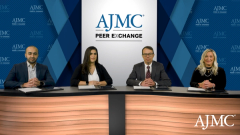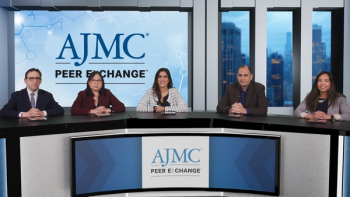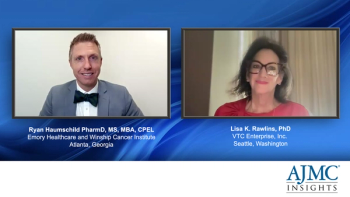
Overview of Relapsed / Refractory Multiple Myeloma
Jeffrey Matous, MD, leads a panel discussion surrounding the use of bispecifics treatment of relapsed / refractory multiple myeloma.
Episodes in this series

Jeffrey Matous, MD: Hello, and welcome to this AJMC® Peer Exchange® program entitled “Treatment with Bispecifics In Relapsed/Refractory Multiple Myeloma.” I’m Dr Jeffrey Matous. I’m a member of the Colorado Blood Cancer Institute in Denver, Colorado. I’m going to let my colleagues introduce themselves who are joining me today. We’ll start with you.
Beth Faiman, PhD, APN-BC, CM: Thank you. My name is Beth Faiman. I am a nurse practitioner in the multiple myeloma program at the Cleveland Clinic in Ohio.
Zahra Mahmoudjafari, PharmD, MBA, BCOP, FHOPA: Hello, everyone. My name is Zahra Mahmoudjafari, and I’m a clinical pharmacy manager at the University of Kansas Cancer Center in Kansas City, Missouri.
Kirollos Hanna, PharmD, BCPS, BCOP, FACCC: Hi, everyone. I’m Kirollos Hanna, the director of Pharmacy at Minnesota Oncology. I’m also an assistant professor at the Mayo Clinic College of Medicine in Rochester, Minnesota.
Jeffrey Matous, MD: A great panel indeed. Today our panel of experts will explore the clinical impact of relapsed/refractory multiple myeloma. What it means to discuss treatment paradigms in these usually heavily pretreated patients with multiple myeloma, including CAR [chimeric antigen receptor] T-cell therapy, and the bispecific T-cell redirecting antibodies, and address challenges regarding patient access to these advanced therapies. Thanks all to the panelists for joining us today and let’s go ahead and begin.
Beth, would you please start us off with an overview of relapsed/refractory multiple myeloma. What is it? What does it mean? What’s the impact of that?
Beth Faiman, PhD, APN-BC, CM: I don’t have an hour to discuss myeloma overview of relapse, but I’ll discuss it briefly. As many of you know, it’s cancer of the bone marrow plasma cells. In patients with relapse disease, we see that they were given often induction chemotherapy, and then they went through sometimes transplant and then a maintenance phase. After that period of time, a majority of them will unfortunately relapse. Those relapses can be biochemical where the paraproteins are just increasing gradually, or they can be symptomatic where they have new bone lesions, kidney disease, or other. The challenge with myeloma is keeping these clones in check.
We know that Jonathan J. Keats, PhD described in 2012 the concept of clonal evolution, where that clone that was the dominant clone might change over time. That’s the reason for maintenance therapy. The relapsed/refractory patients in early relapse, I think, are so different. I don’t know what your thoughts are in the multiple relapse setting as well. What are your thoughts about relapsed/refractory patients?
Zahra Mahmoudjafari, PharmD, MBA, BCOP, FHOPA: Absolutely. I would say with every line of therapy, the patients become more and more deconditioned. They’re more and more difficult to manage. Absolutely. The longer, and we all obviously know that multiple myeloma continues to be a disease that remains without a cure. It’s really trying to minimize the amount of harm for as long as possible that we can. I agree. I absolutely think that that is a challenge.
Kirollos Hanna, PharmD, BCPS, BCOP, FACCC: Correct. I couldn’t agree with you more. I think too, one key thing about myeloma is we’re looking at that relapsed/refractory setting for the patient population. Just understanding how refractory these patients are. Are they still responsive to some IMiDs [Immunomodulatory imide drugs] or some PIs [proteasome inhibitors] and different combinations, or are they deemed to be penta refractory? Because I think that the patient population becomes a lot more difficult to treat.
Then you start to think of things like, what we’re going to discuss today—bispecifics and CAR T-cell therapy. It’s been a really exciting, I think, landscape and that relapse remitting or relapsed/refractory setting. But to Zahra’s point, I think as we move further and further into the line of therapy for our patients, we start to lose more and more patients during those relapses. But I’m very excited to see these new novel targets.
Beth Faiman, PhD, APN-BC, CM: I was just going to say there was a recent study that suggested that at each line of therapy, you get an attrition rate of about 20% to 30%. Getting your best first therapy upfront might be the best option, but there’s a lot of controversy in sequencing, which I’m sure we’re going to get to later.
Jeffrey Matous, MD: I’m a believer in the play-your-best-hand first philosophy for sure. But aren’t there relapses? There are relapses, right? There were some patients who have relapses that are indent or biochemical like you said, Beth, that we can see coming from a long way away. Then their relapses are quite aggressive, where you’re already worried about maybe new clones and new behaviors. Is our approach different for those different types of relapses?
Beth Faiman, PhD, APN-BC, CM: I would say that with good communication, I think one of the problems we get into trouble with is in the community and they referred to the large hospital system, they got the transplant. Then they’re on lenalidomide [Revlimid] maintenance. Then who’s watching their myeloma? Who’s checking the biomarkers? Who’s ensuring that the patient is taking their maintenance therapy as recommended? Then those are the patients that come back to you with that fulminant relapse, that symptomatic relapse. I think monitoring is really important.
We talked about the clonal evolution. Our standard of care at that first or second relapse is to repeat a bone marrow. We know we're looking for these 17P deletions. They might have been standard risk at diagnosis. Now they have a gain of 1q. Looking at the biology of the myeloma in the bone marrow microenvironments, just as important when we're personalizing therapy.
Jeffrey Matous, MD: What do we think these days about the epidemiology, if you will, of relapsed/refractory myeloma? That is when are patients relapsing now? Because our upfront therapies have improved so much over the years. What’s your guys’ experience?
Zahra Mahmoudjafari, PharmD, MBA, BCOP, FHOPA: I think for me and for our center we are a large referral center. For us, all our patients are relapsed/refractory in some way or another. The median age of diagnosis for any myeloma patient is about 69 years old. As well as we’re doing with our current therapies, you’re adding a few years to that at this point. These patients are elderly, typically. They have significant comorbidities that we have to manage. It’s not just the multiple myeloma that we’re managing. They do tend to be very complex patients.
Kirollos Hanna, PharmD, BCPS, BCOP, FACCC: I would totally agree. I think when we look at this patient population and we’re looking at their journey, one thing in terms of the disease state in general that I tell my students and residents when we talk about myeloma, you see all of the oncology in a single disease state. We see patients who are getting treated with these aggressive therapies. You see transplantation. You see CAR T-cell therapy. And now you see bispecifics. You see patients requiring a lot of supportive care to address the needs of their medication or to offset some of those adverse events you’re going to see from medications.
But also supportive care to help address your standard CRAB [hypercalcemia, renal failure, anemia, bone disease] symptoms. Your bone-modifying agents, and so on and so forth. I think the disease as these patients go through their journey, and again, they become more difficult to treat, as Beth said, especially those who have certain translocations or poor-risk cytogenetics that can develop in terms of epidemiology can develop during different phases of their disease. You treated them. You didn’t transplant them because they didn’t have poor-risk cytogenetics. But then now you’re 3 lines in and something develops so you see a translocation.
Beth Faiman, PhD, APN-BC, CM: That's where it goes to health-related quality of life. At upfront, we think patients will go through the induction, consolidation then transplant phase. You should have the same health related quality of life as those who did not get a transplant. Looking at the relapsed / refractory population, is that the same? If you've had second relapse, third relapse, we already talked Zahra about how heavily pretreated people can be very symptomatic and the sequela of the disease. But we know with the CARTITUDE studies, I know we'll talk about bispecifics later on. But there has been an improvement in quality of life even in those patients that have had therapy with idecabtagene vicleucel. Then there’s the ciltacabtagene. At the end of the day, there have been some quality of life studies. These are important end points, the progression-free survival. But it underscores the importance of survivorship at diagnosis. We can keep people with their healthy behaviors, educate them as to what things to do to take care of themselves if they're in the community and not in the large hospital system. Things like healthy diet, exercise, etc. It's like that whole multidisciplinary team is the key.
Beth Faiman, PhD, APN-BC, CM: Close enough. At the end of the day, there have been some quality-of-life studies. These are important end points, the progression-free survival. But it underscores the importance of survivorship at diagnosis. We can keep people’s healthy behaviors and educate them as to what things to do to take care of themselves if they’re in the community and not in the large hospital system. Healthy diets, exercise, etc. That whole multidisciplinary team is the key.
Zahra Mahmoudjafari, PharmD, MBA, BCOP, FHOPA: I think you bring up a really good point though because there isn’t a straight-line option for the treatment of these patients. It’s a very curvy, twisty, full-of-drama road. You’re right, the multidisciplinary team is so important, especially for these patients.
Transcript edited for clarity.
Newsletter
Stay ahead of policy, cost, and value—subscribe to AJMC for expert insights at the intersection of clinical care and health economics.















































